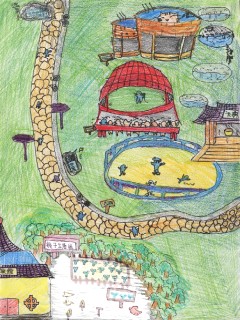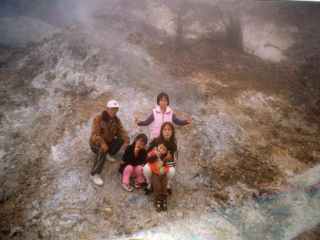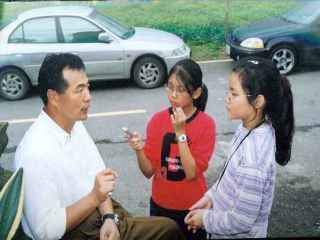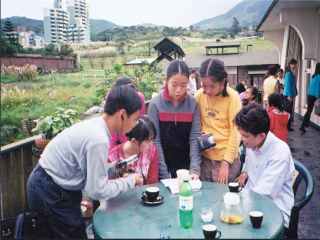research
project elements
|
1. How does the research
project benefit your teaching and course requirement?
¡@Information
education has been the main focus of our school's curriculum
for some time now. We begin computer classes at the third
grade level, which aims at providing students with a basic
idea on information, child/parent computer classes are
another source of education in our system. On
a more advanced level, students learn about more in-depth
internet concepts and intranet ideas. This project, the
"Taipei virtual hotspring" is a testament to
the abovementioned efforts that our school has put in
to our students. On
a more advanced level, students learn about more in-depth
internet concepts and intranet ideas. This project, the
"Taipei virtual hotspring" is a testament to
the abovementioned efforts that our school has put in
to our students.
Due to our country's
latest attempt at education reform, we have tried extremely
hard to abide by the guidelines and visions set forth
by the government. In detail, our government has listed
7 major fields of learning for the children of our country,
and the following answers to the questions shall explain
with examples and sincerity how an international webpage
competition can actually help contribute, strengthen,
and actualize the more vague education reform ideas of
a small country named Taiwan:
¡@¡]1¡^Linguistic field-- Reading,
analysis, and management of collected data; writing, editing,
and interviewing all demonstrate the use and importance
of linguistic abilities.
¡@¡]2¡^Social field-- We utilized
the resources of our community, and tried to search for
the history and roots of the place we live in, and we
have developed sense of care and love for the motherland
in the process.
¡@¡]3¡^Mathematics field--Interviews
with people, and the statistical analysis afterwards,
and the geographical location and re-location of tourist
sites all help students develop mathematical and spatial
concepts.
¡@¡]4¡^Natural sciences field--
"hotspring region" itself provides numerous
opportunities for students to receive first-hand and hands-on
experience on the water quality and ecosystem of the environment
closest to their lives.
¡@¡]5¡^Health and physical education
field--The time arrangement, activity schedule,
and field trips all help this field.
¡@¡]6¡^Arts
and humanities field--Through photo contests, computer
graphics, and recreations of tourist sites on drawings,
kids learn and apply their artistic talent and taste wonderfully.
¡@¡]7¡^mixed field--The team
spirit, cooperation, communication, exploration, and on-site
interviews help the students mature and become more responsible
adults.
¡@In addition, we strongly encourage our students to do
three things:
care about the
community, think what you can do to improve the community,
and most importantly, DO what you THOUGHT could help the
community. Thus we begin, underwent, and finished this
project.¡@
|
|
2.What information
technologies did you use to help finish your project?
¡@As
with any other science/social/humanities project of this
scale, EVERY POSSIBLE RESOURCE was utilized by us. Just
to name a few, we received a telephone call from our instructor,
and took the MRT to the Baytow Hotspring Museum, where
the guide there showed us slides on a large screen projector.
In addition, we found out their
number on the internet, then confirmed that the phone
was the most convenient means of communication, then we
checked out information from libraries, websites, and
bookstores for written data.
As for the more recent updates
and happenings, we resorted to the news programs on TV
and the radio. In fact, we had to watch a television show
produced on the same topic, hotsprings, on Channel Three
every weekend to get more relevant information. As we
go to the actual sites, digital cameras were helpful in
editing and storing the photos, but some parents felt
that traditional cameras capture light a little better,
thus comes in the play of scanners. During interviews,
we found that tape recorders were much better and accurate
than just jotting down notes here and there.
¡@When we have accumulated enough
data, under the guidance of instructors, we used softwares
such as Little Painter and PhotoImpact to assist us in
the artistic work of the webpage via computers. Also we
transformed the Microsoft word documents one by one to
the appropriate files, namely, the HTML files, and then
we transformed that again to simply text files, which
are then edited and arranged by Dreamweaver, before they
are finally uploaded to the designated contest site via
uploading softwares.
|
|
3.How did you,
through personal influence or online contact, play the role
of "ambassador" for this cyberfair?
¡@The
"Taipei virtual hotspring" project was both
larger in scope and larger in reallife size. The Yangmingshan
is situated at the Datoon volcano region, which makes
it quite difficult to photograph and collect data. Thus,
we held school-wide photo competitions in order to let
everyone know about this project, and hopefully call to
their attention our precious environment, how beautiful
it is, and how dangerous it is to neglect it or even destroy
it. After the competition we realized that there are so many
more caring parents than we expected. They not only care
about their children,
but also about the community they live in. In fact, they
cared also about the children of other families and the
next generation. Thus parents were all excited and anxious
to share whatever resources they had to offer, as well
as provide precious experiences and knowledge about the
project.
After the competition we realized that there are so many
more caring parents than we expected. They not only care
about their children,
but also about the community they live in. In fact, they
cared also about the children of other families and the
next generation. Thus parents were all excited and anxious
to share whatever resources they had to offer, as well
as provide precious experiences and knowledge about the
project.
A friend of our parents, for example,
provided us a clue which ultimately led to the discovery
of the owner of "beauty dip" in the Tienlai hotspring
region. Mr. Hong, the owner, was not only friendly
and kind, but also well-read and knows everything there
is to know to the region. He generously offered us a full
day of "educational tour", consisting of a "walk
back to time" -- the sulfur trail visit, and to find
the fountainhead of hotsprings, and what made us all happy
and excited was: we all got to take comfortable dips and
great meals afterwards!
the owner of "beauty dip" in the Tienlai hotspring
region. Mr. Hong, the owner, was not only friendly
and kind, but also well-read and knows everything there
is to know to the region. He generously offered us a full
day of "educational tour", consisting of a "walk
back to time" -- the sulfur trail visit, and to find
the fountainhead of hotsprings, and what made us all happy
and excited was: we all got to take comfortable dips and
great meals afterwards!
¡@We also set up "hotspring gremlins" village
in the internet community which provides different people
to exchange thoughts and ideas on the project.
|
|
4.What influence
and impact did the project have on you?
¡@The
students in this project are the first group of students
who were completely educated under the education reform
program in our country starting in 1996. Their creativities
exceed their fundamental trainings, and thus this project
provided an excellent opportunity for the instructors
to train and instill some seriousness and hard-working
attitude in these kids.
¡@In conducting the relevant research for this project,
we realized two things: one is that there were already
quite a few researches, books, and ideas on the region;
two is that we are extremely lucky to be blessed with
such treasure in our environment. However, as we studied
the region even deeper, we realized that there are also
many problems that demand to be solved in this wonderful
community. Thus, we decided to think of some ways to improve
and reform her. However, due to legal restrictions and
practical considerations, we couldn't physically go "change"
or "tear down" certain places. Thus, the creative
students and intelligent instructor of our team came up
with the simple yet fun and refreshing idea of "regional
make-over". What we would do is that we would divide
among ourselves several regions. Then we would each try
to give the region a make-over, both in theory and in
practice. The "practice" part would be to actually
design, draw, and create a virtual blueprint for the region
in question. We found this idea not only creative, but
also help us analyze deeper and explore further the infinite
possibilities of changing the place. The possibilities
are infinite because we were only drawing them on paper,
but at the same time the analysis could go deeper than
usual because of the same reason.
In other words,
we have become the creators of our environment, not just
a passive resident who simply accepts what is already
there.
|
|
5.How did your
local community members provide assistance to your project?
¡@
In order to finish a project
of this detail and scope, a team of poeple is definitely
needed. Luckily, we could always trust and rely on our
fellow citizens.
¡]1¡^DYNA COLOR,INC,
upon learning that we were still going to integrate "technology"
with "humanities", generously sponsored our
webpage production, making us a good example of how businesses
and education could mutually compliment each other.
¡]2¡^Mr. Shee, the local gentleman, upon hearing our project,
wisely reminded us that the Baytow hotspring region has
already been discussed too much, and that we ought to
focus on the less talked about, but equally interesting
and important Yangmingshan region ( also known as the
Grass Mountain, due to the spectacular Mon Grass that
fills the mountainsides )
¡]3¡^During the beginning phase of research, Mr. Young Wen,
Dong Hwanshin, and Ms. Hsu Shuming sacraficed quite some
time to brainstorm with our team members and we owe them
our deepest thanks.
¡]4¡^The parents are highly
supportive of the way we uses project research to apply
what we learned in class to real life experiences, especially
when it involves our own community. In addition to helping
us with finding resources and financial support, they've
also surprised us with their incredible artistic talent
when they shone in the photo contests.
¡]5¡^Yangmingshan National Park Office
has trained their guides well. The volunteers not only
told us everything they know, and kindly offered to help
with some research, but also taught our students by example
how one can always give back to the community through
what one has learned in class and in life.
Also, Mr.Hong Tiending showed
us how to develop communities and regions and Mr. Wang Waytren, Mr. Lin Mingyi both helped us
shoot some wonderful photographs. Last, but not least,
we owe much thanks to the people who accepted our interviews
and gave us candid answers.
Mr. Wang Waytren, Mr. Lin Mingyi both helped us
shoot some wonderful photographs. Last, but not least,
we owe much thanks to the people who accepted our interviews
and gave us candid answers.
|
|
6.discoveries,
lessons, and surprises
¡@Whithead's
theory on what is called the "inter knowledge"
clearly points out to us the setback of traditional education.
From a teaching material's point of view, the textbook
designs are too hung up on the "structure" of
knowledge, instead of learning more about the "big
picture", which is often times less clear to convey
in words and put into a "structural" form. Thus
students of the traditional education system often find
it difficult to learn simultaneously through different
fields.
Our project, then, focuses
on helping students to understand "when" and
"how" to apply what he or she has learned; we
tried to put some incentive for them to learn, and in
turn they will find a deeper learning strategy to manage
the knowledge learned. Only through the integration of
knowledge and life will the students feel the pleasure
and joy of learning.
¡@When the classrooms are moved to the outdoors, the contents
are immediately more lively and more fun, thus more tempting
to the students. When creativity comes into play, everything
is brought to even newer heights. Our students have learned
not only to accept knowledge as we receive it, but also
through the intelligence and creativity of our mind, we
have successfully "transformed" and "elevated"
the old information, and made it into something different,
something new, and something more. That,
our dear fellow citizens of this global village, is what's
important,that's what keeps us improving, that's what
makes life bearable, that's what really counts. That,
our dear fellow citizens of this global village, is what's
important,that's what keeps us improving, that's what
makes life bearable, that's what really counts.
In conclusion, through learning
about your community, then making it into something new,
something different, something more -- that is called
"education".
And this refreshing definition
of "education" has been, still is, and always
shall be,the greatest reward of our months and months
of hardwork put into the project.
In fact, this "education"
itself is our very own discovery, lesson, and surprise
in life.
|
¡@
|






















